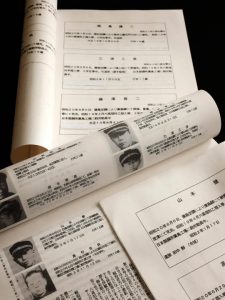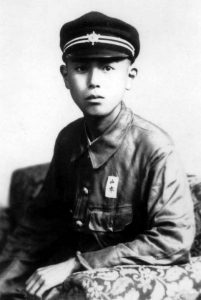Striving to fill voids in Hiroshima, evidence of victims remains—List of war dead from Okayama’s Sixth Higher School, including three students killed in A-bombing, donated to Peace Museum
Dec. 25, 2023
by Kyosuke Mizukawa, Senior Staff Writer
A list of war dead from the old education system’s Sixth Higher School, the predecessor to Okayama University that had been located in Okayama City’s present-day Naka Ward, was donated this month to the Peace Memorial Museum, in Hiroshima’s Naka Ward. The list was created by the school’s alumni association and includes names of three second-year students who had been mobilized to a munitions factory in Hiroshima and died in the atomic bombing. With the dearth of materials about A-bomb victims from the Sixth Higher School, a niece of one of the victims entrusted the list to the museum in the hopes that “people will come to know about my uncle and other student victims.”
The Sixth Higher School was founded in 1900. The late physicist Yoshio Nishina, who surveyed the devastation caused by the atomic bombing of Hiroshima, was a graduate of the school. During the war, students at the school were grouped by club activity and mobilized to work in munitions factories. Members of the track and field club and the gymnastics club were sent to the Hiroshima Plant of Japan Steel Works, located in what is now Hiroshima’s Aki Ward, where they made artillery shells and lived in a dormitory.
According to a personal account written by a former student who had been mobilized to Hiroshima, August 6, 1945, was their first day off in two months. The blast from the bomb shattered the windows of the dormitory, located around five kilometers from the hypocenter, but the students inside were saved because the building did not collapse.
Nevertheless, some students had been in the city center on personal business. Three second-year students died of severe burns from the bombing’s thermal rays. By 2008, a survey conducted in Hiroshima by the alumni association confirmed 230 student deaths in the war, including those who had sent to the battlefield after graduation and the three A-bomb victims. The association made the list of war dead and put together a booklet describing when and how the victims died.
The idea of donating the list came from Kiyomi Ohara, 61, a resident of the area of Tadotsu in Kagawa Prefecture who is the niece of Tsuyoshi Yamamoto, one of the three A-bomb victims. She often heard her mother, Mr. Yamamoto’s younger sister, and father, his high school classmate in the old school system, expressing their remorse about what happened in the bombing.
Mr. Yamamoto, also from Tadotsu, was a member of the track and field club and dreamed of becoming a physician. “I heard my uncle was a hard worker. When sleepy, he would pour cold water on his face and continue to study,” Ms. Ohara said. He experienced the atomic bombing near Hiroshima Station. Classmates cared for the badly wounded Mr. Yamamoto and carried him to his parents’ home. However, on September 2, 1945, he died at the age of 18.
Hoping to console her uncle’s soul, Ms. Ohara donated the list along with past alumni newsletters containing photographs of Mr. Yamamoto and other victims and the personal accounts of the atomic bombing written by classmates. The alumni association cooperated by providing remaining newsletters.
The museum made a list of the number of A-bomb victims by school in Hiroshima Prefecture for a special exhibit held in 2004, but it was unable to extend the survey to schools located outside of Hiroshima Prefecture. The Record of the Hiroshima A-bomb War Disaster, a representative document published in 1971 of the devastation caused by the atomic bombing, describes the Sixth Higher School students who had been mobilized to the Hiroshima Plant of Japan Steel Works, but does not mention the students who had been killed in the bombing.
Chie Shijo, an associate professor at the Hiroshima City University’s Hiroshima Peace Institute and a former curator at the museum, said, “The alumni association’s thorough research resulted in important materials for understanding the damage done to those who had been mobilized to Hiroshima from outside the prefecture.”
(Originally published on December 25, 2023)
A list of war dead from the old education system’s Sixth Higher School, the predecessor to Okayama University that had been located in Okayama City’s present-day Naka Ward, was donated this month to the Peace Memorial Museum, in Hiroshima’s Naka Ward. The list was created by the school’s alumni association and includes names of three second-year students who had been mobilized to a munitions factory in Hiroshima and died in the atomic bombing. With the dearth of materials about A-bomb victims from the Sixth Higher School, a niece of one of the victims entrusted the list to the museum in the hopes that “people will come to know about my uncle and other student victims.”
The Sixth Higher School was founded in 1900. The late physicist Yoshio Nishina, who surveyed the devastation caused by the atomic bombing of Hiroshima, was a graduate of the school. During the war, students at the school were grouped by club activity and mobilized to work in munitions factories. Members of the track and field club and the gymnastics club were sent to the Hiroshima Plant of Japan Steel Works, located in what is now Hiroshima’s Aki Ward, where they made artillery shells and lived in a dormitory.
According to a personal account written by a former student who had been mobilized to Hiroshima, August 6, 1945, was their first day off in two months. The blast from the bomb shattered the windows of the dormitory, located around five kilometers from the hypocenter, but the students inside were saved because the building did not collapse.
Nevertheless, some students had been in the city center on personal business. Three second-year students died of severe burns from the bombing’s thermal rays. By 2008, a survey conducted in Hiroshima by the alumni association confirmed 230 student deaths in the war, including those who had sent to the battlefield after graduation and the three A-bomb victims. The association made the list of war dead and put together a booklet describing when and how the victims died.
The idea of donating the list came from Kiyomi Ohara, 61, a resident of the area of Tadotsu in Kagawa Prefecture who is the niece of Tsuyoshi Yamamoto, one of the three A-bomb victims. She often heard her mother, Mr. Yamamoto’s younger sister, and father, his high school classmate in the old school system, expressing their remorse about what happened in the bombing.
Mr. Yamamoto, also from Tadotsu, was a member of the track and field club and dreamed of becoming a physician. “I heard my uncle was a hard worker. When sleepy, he would pour cold water on his face and continue to study,” Ms. Ohara said. He experienced the atomic bombing near Hiroshima Station. Classmates cared for the badly wounded Mr. Yamamoto and carried him to his parents’ home. However, on September 2, 1945, he died at the age of 18.
Hoping to console her uncle’s soul, Ms. Ohara donated the list along with past alumni newsletters containing photographs of Mr. Yamamoto and other victims and the personal accounts of the atomic bombing written by classmates. The alumni association cooperated by providing remaining newsletters.
The museum made a list of the number of A-bomb victims by school in Hiroshima Prefecture for a special exhibit held in 2004, but it was unable to extend the survey to schools located outside of Hiroshima Prefecture. The Record of the Hiroshima A-bomb War Disaster, a representative document published in 1971 of the devastation caused by the atomic bombing, describes the Sixth Higher School students who had been mobilized to the Hiroshima Plant of Japan Steel Works, but does not mention the students who had been killed in the bombing.
Chie Shijo, an associate professor at the Hiroshima City University’s Hiroshima Peace Institute and a former curator at the museum, said, “The alumni association’s thorough research resulted in important materials for understanding the damage done to those who had been mobilized to Hiroshima from outside the prefecture.”
(Originally published on December 25, 2023)









